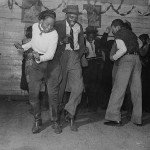Feeling groovy – microtiming in swing and funk
Hello Dear Reader,
Well, here we are in 2016! This blog enters its 6th year of existence and you and I continue to learn more and more about the wonderful world of music psychology. It makes me feel like having a little dance in celebration. And with that thought in mind, I turn to the new paper of interest for this blog.
Microtiming in Swing and Funk affects the body movement behaviour of music expert listeners by Lorenz Kilchenmann and Olivier Senn, published August 2015 in the journal Frontiers in Psychology.
Lorenz and Olivier are colleagues of mine from the Hochschule Luzern in Switzerland. I was living in Luzern and working alongside their team during the time that Lorenz was collecting the data and Olivier was working away on the numbers. I know first hand about the great deal of time and effort that went into the study. I even did the prize draw for the participants! Hence I was very excited to see the paper finally in print and it is my pleasure to give you a run down of the juciest parts.
 Musical entrainment is the fancy term used by academics to describe our ability to move to a beat; to tap our feet, bob our heads, or clap our hands.
Musical entrainment is the fancy term used by academics to describe our ability to move to a beat; to tap our feet, bob our heads, or clap our hands.
In my classes the example I always use is the Stevie Wonder track ‘Superstition’ (1972).
It is quite fun to play the track in class and tell the students to try to keep absolutely still. Don’t even twitch. It is harder than you think! Have a listen and play the game for yourself – Superstition (1972)
By the way did you know that Stevie Wonder was born Stevland Hardaway Morris? Fun fact for a quiz there.
The interesting point is that we don’t really know WHY we have this urge to move to music, let alone how we are able to keep a beat (the latter is a story for another day).
The new article tests the idea that tiny timing discrepancies in the performance of beat-oriented music, like Superstition, is what triggers entrainment. They call these timing triggers ‘Participatory Discrepancies’ or PDs.
PDs actually cover a range of tiny shifts in music structure that could include timing, pitch, timbre or dynamics, though today the term is used almost exclusively to refer to timing shifts in attack and release. According to Keil (1995), PDs are not a part of the composition but are created interactively in performance.

The authors of the present study wanted to use live performances rather than artifically created sound files, a step which I think marks an important shift in thinking in this field, since PDs are supposed to arise from natural musical communication between players. They recorded two professional musicians, a drummer and a bassist, playing in a studio jam session. They then manipulated the scaling of the magnitude in the PDs without changing the relationship between the onsets.
Previous research from Butterfield (2010) suggested that listeners could not consistently identify PDs of magnitude 30ms or less, which is odd given that most PDs in actual performance fall in this range.
So are PDs responsible for our urge to groove or not? Here is where the new experiment comes in.
As said above the authors used authentic performances, ensuring that the introduction of arbitrary introduction of PDs post hoc was not an issue. They used 20 seconds of two musical styles, Swing (150bpm: 12 bar harmonic sequence) and Funk (100bpm: 8 bar harmonic sequence).
Most importantly they not only took measures of perceived groove (i.e. questionnaires – to be reported in a later study) but they measured peoples’ actual beat-related head movements using motion capture technology.
During the original recordings the two musicians heard a metronome over headphones as a beat reference. The musicians themselves selected the recordings that they felt had the best groove.
The drum beats were later replaced by samples using a sub-millisecond precision software in order that the PDs could be manipulated in the experiment. The musicians checked the baseline recordings with the substituted drum track to ensure that aesthetic quality was not infringed.
Within each track (Swing and Funk) a metronomic grid was established that represented the pattern of timing events according to the strict timing of a metronome. The PD of each event (157 events in Swing, 214 events in Funk) was calculated as the extent to which each beat deviated from this grid.

In Swing the musicians played more events ahead of the grid than in Funk. This implies that Funk has a naturally ‘tighter’ adhearence to strict beat, which is in accordance with previous studies.
Furthermore the bassist had ‘looser’ timing than the drummer, which is again consistent with reports of timing from different instrumental experts.
For each style 12 manipulations were created: 6 scaled the PD 20% down from the original (tightened) and 6 scaled the PD 20% up from the original (loosened).
In the two extremes, the 100% shifts, the stimuli were perfectly quantized or ‘deadpan’ meaning that all event onsets sounded exactly on the metronomic time grid.
The study was carried out using 160 participants divided into four groups: one for each musical style and one for musical experts and one for non-experts. Participants listened to all the samples from their assigned style, randomized. They were also videotaped, though they were not told why this was being done at the time.
The authors hypothesised that the music clips with the original PDs would trigger the strongest entrainment in terms of how much people moved in response to the music.
Is this what happened?
Overall there were no differences between the two styles. What happened in Swing also tended to happen in Funk.
The first finding was that music experts reacted more strongly to the PD manipulations than the non-experts. This challenges the idea that entrainment is a universal response to music, though only in the sense of who actually moves and responds to groove in the ways measured in the study, the head movements. However, it might explain why previous studies did not find any influence of PDs on entrainment. Previous studies mostly used non-experts.
 The big surprise was that they found no evidence that the original PDs played by the musicians were associated with the strongest reaction in any of the listeners. In fact the samples shifted 60% down triggered more entrainment in listeners compared to the deadpan versions.
The big surprise was that they found no evidence that the original PDs played by the musicians were associated with the strongest reaction in any of the listeners. In fact the samples shifted 60% down triggered more entrainment in listeners compared to the deadpan versions.
In other words people moved to music that was much tighter to strict metronome beat than the musicians had chosen to produce naturally.
Future studies have some fun avenues to follow. Firstly, the participants were seated in the present study, in deference to the fact that it took around 45 minutes. In the future, with fewer conditions, the authors can try more free movement conditions to see if reactions change.
They would also like to break down the idea of ‘music expert’ to look at more in depth ideas of musical experience, training and listening preferences.
Overall this new study offers some support for the idea that PDs may be at least partly responsible for why some of us feel the urge to groove to music. But the story is more complex than simple timing shifts.
Importantly there is growing evidence that the PD effect is a function of musical expertise, which means that PDs are unlikely to explain all our natural urges to groove, for example the moves we see in little babies. See this clip for an amusing aside on babies grooving.
So what else might explain our grooviness? Two possibilities are beat salience and music loudness. The search for an answer continues …
